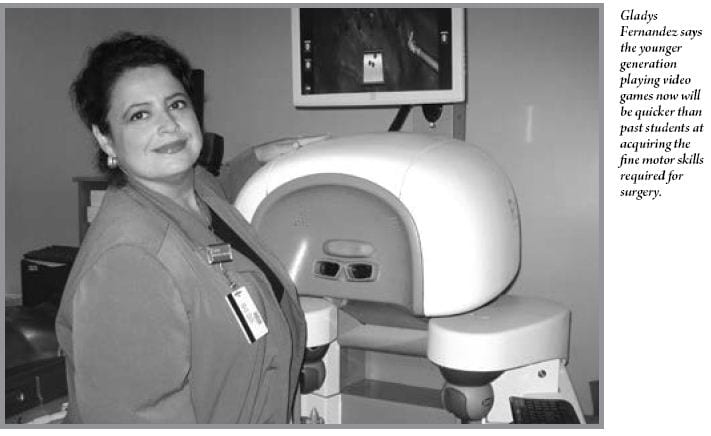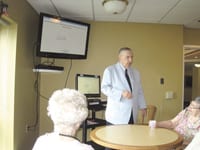Serious Play – High-tech Games Become Therapy, Learning Tools in Healthcare
Game playing is a common sight these days, not only among young people, but across all generations, as the popularity of electronic games that help people pass the time — on smartphones, tablets, TV screens, and computers — is exploding. But those games, or games that are very similar, are also quickly becoming therapeutic tools in the healthcare industry for various modes of patient care and training for medical education — making treatment and learning both more effective and more fun.
Ron Pond has a new toy of sorts for use in his job as activities director for Reflections, an interactive memory program at Mason Wright Retirement Community in Springfield.
While its official name is ‘Linked Senior,’ he simply calls it ‘the kiosk,’ and in the four short months that the senior-living facility has been using the web-based, cutting-edge technology program on a large screen, the more than 90 residents have had more fun than ever before, Pond told HCN. But they’re also getting therapy.
The program, which can be enjoyed by many in one room (one of it’s main pluses), mimics elements of electronic games that people of all ages already play, such as Words with Friends, Candy Crush Saga, and Facebook’s Farmville. But the kiosk also offers newsreels, music, thousands of high-definition images, travel destinations, and trivia regarding hundreds of subjects.
“It’s difficult to hit everybody’s likes and dislikes, but the kiosk comes as close as anything I’ve ever seen,” Pond said. “It’s visual and it’s diverse, and there is one feature that is an inexhaustible supply of just colors on screen, and they really love that.”
“Obviously, being here, these residents have a daily exercise routine to keep their muscles in as good shape as we possibly can — and I exercise their mind,” he explained.
For his clients, 25{06cf2b9696b159f874511d23dbc893eb1ac83014175ed30550cfff22781411e5} of whom are suffering from various levels of dementia and Alzheimer’s disease, the games they can play through the kiosk are serious business.
Indeed, Pond is utilizing a new segment of gaming, grouped by the term ‘serious games,’ which has been growing rapidly and steadily in the healthcare sector for the past decade.
The serious-games movement includes video games and virtual-reality games played on smartphones, tablets, computers, and other visual monitors that can be used in many forms of patient treatment as well as healthcare education.
Dr. Gladys Fernandez, assistant program director of the Baystate Surgery Residency Program, director of surgical education programs, and manager of the Baystate Simulation Center, knows the importance of games in medical education because she witnesses doctors and medical students playing them all the time in the center.
The ‘sim lab,’ as it is known, is one of the first simulation centers in the world to be accredited by the American College of Surgeons as a Level I Comprehensive Education Institute, and it’s filled with virtual-reality games and interactive surgical training games that teach doctors and medical students the precise skills required for performing minimally invasive surgical techniques and operating the highly technical robotics that are becoming the norm in any OR.

“With Generation Y [born between 1985 and 2004], they’re really adept at technology, and we’ve seen that training curricula in learners who have experience with video gaming can actually shorten the time it takes to learn certain technical tasks,” said Fernandez.
It’s apparent that millions of people of all ages love anything related to games, either on handheld electronics or systems like the popular Nintendo Wii or Xbox Kinect. According to the Entertainment Software Assoc., 51{06cf2b9696b159f874511d23dbc893eb1ac83014175ed30550cfff22781411e5} of U.S. households own a dedicated game console — and those that do own an average of two — and 58{06cf2b9696b159f874511d23dbc893eb1ac83014175ed30550cfff22781411e5} of all Americans play video games. In 2012, those gamers spent $20.77 billion on video games, hardware, and accessories.
As gaming has also swiftly grown in the healthcare industry over the past decade, it has spawned an initiative called the Games for Health Project, which supports community, knowledge, and business-development efforts to use cutting-edge game technologies that can improve health and healthcare.
In fact, this past June, the 9th annual Games for Health Conference was staged in Boston, allowing more than 400 attendees to learn more about advancements in the five categories of games that the Games for Health Project has designated as benefiting many areas of healthcare (more on these later).
For this issue’s focus on technology, HCN visited with area healthcare providers and educators to get a first-hand look at how high-tech games are changing how they treat patients of all ages and train the region’s current and future physicians.
The Game of Life
Clearly, video games are no longer just a lazy activity for kids, as Fernandez noted, but the younger generations are the first to have literally grown up playing video games, so more development and innovation is sure to come.
In response to this exploding trend, the Games for Health Project has broken down the areas of healthcare in which games benefit patients and students. They include:
• Cognitive and emotional health, a category includes games that improve brain health or memory, and can be used by seniors suffering with various levels of dementia and Alzheimer’s disease, as well as those with brain damage, learning disabilities, mental disorders, and emotional issues;
• Participatory health, which represents a way for patients to become more active in their own care through the use of mobile apps, and also keep up with medications and treatment programs in a fun, interactive way. A popular example is the game Re-Mission, in which young adults living with cancer play ‘Roxxi the nanobot’ who travels through the body of a cancer patient while destroying cancer cells and managing side effects;
• Exergaming, which relies on technology that tracks body movement or reaction. Popular games include Nintendo’s Wii Fit, Ubisoft’s Just Dance series, and Xbox Kinect Training. It helps people fight obesity and can be used as therapy for a variety of disorders and disabilities;
• Rehabilitation games, which can be used for physical therapy, occupational therapy, motor skills, and balance treatment programs; and
• Medical Education and Training. The medical field can benefit from gaming through video, computer, and mobile games, which can assist with professional training, surgical training, and a wide range of medical education topics.
Before Linked Senior, or the kiosk, which fits in the category of cognitive and emotional health, but also involves a bit of the participatory-health segment, Pond said his activity game bag included a storage room full of board games, balls, and whatever he could bring to the table — whether that was his own personal storytelling, reading the paper or books to patients, and watching TV or movies as a group.
The key to the use of games, said Pond, is that activity satisfaction is achieved by engaging and challenging residents, from the low-functioning to the most alert, in meaningful stimulation. Isolation of low-functioning individuals from those with intact memories is not an option, he explained, because the separation is a social and emotional killer for the memory-impaired.
Pond runs 45-minute to one-hour segments for the residents, which he describes as “quality brain exercising” time, just long enough to not wear his clients out. A former hospital CEO, Pond has gained first-hand insight into how important the social interaction of gaming is.
“It wasn’t until I started in the activities field that I started to understand what this is all about; it’s been a very moving experience for me,” said Pond. “We do have the Wii here, but if you put it side-by-side with the kiosk, they’d go for the kiosk every time.”
Tina Fortier, senior physical therapist and certified vestibular therapist at Attain Therapy + Fitness in West Springfield, has seen the same positive effects of games in treatment of her patients, but with more physical emphasis. Her use of games falls into both the exergaming and rehabilitation categories.
Fortier focuses much of her patient care on those with vestibular-system issues, including the parts of the inner ear and brain that help control balance and eye movements. Her patients have inner-ear damage from disease, aging, or injury, which can result in vertigo and dizziness, imbalance, vision and hearing changes, and cognitive and psychological issues.

Her patients range in age from children with sports injuries and posture problems to seniors with balance and movement issues or those who are recovering from surgery. With minor modifications for safety, even her senior therapy patients can perform the physical movements on the Wii and the interactive virtual game, Konami’s Dance Dance Revolution.
“Studies have shown that there is a remarkable improvement in balance, coordination, and conditioning, because it’s fun,” Fortier said of the use of games, emphasizing the word ‘fun.’ “So you don’t have that drop-off rate typical of regular exercise programs, because this is engaging and they reap the benefits.”
One of the Wii games Fortier uses places the patient on a virtual soccer field where they have to ‘head’ a soccer ball being kicked at them. But every once in a while, a soccer cleat comes flying at them, and a quick eye and even quicker movement to dodge the shoe is a way to score more points. Laughing at her inability to talk and dodge virtual cleats, Fortier said the game is the perfect form of interaction — and fun — to keep a patient engaged and trying to beat their last score.
With its unique motion-sensing technology and balance board that patients stand on, the Wii game also includes virtual forms of yoga, bowling, tennis, and golf to help the patient improve balance, endurance, coordination, strength, and range of motion.
Fortier said that, while Wii Fit doesn’t replace traditional therapy techniques using different sizes of balls and movement treatments, it provides a change in routine and definitely makes physical therapy more enjoyable and less mundane.
The Game of Operation
The high-tech games in the Baystate sim lab, a perfect example of what’s found in the medical-education and training category, have proliferated significantly in recent years, said Fernandez. Historically, simulation for surgery training started decades ago with the basic knot-tying board, but as technology advanced, so did the different forms of virtual surgical training.
The sim lab offers high-tech simulators for two important goals: teaching how to perfect common procedures, like routine cardiac catheterizations, and introducing surgeons and students to new technology, such as state-of-the-art robotics.
Fernandez demonstrated a game on the RoSS robotic simulator that helps individuals perfect extremely precise motor control of the pointer fingers and thumbs, which will be necessary to perform surgery with advanced robotics. The game requires the player/student to use virtual pliers to pick up two ball bearings, one with the left-hand fingers and the other with the right, and place each on a slim pillar, an action that requires great depth perception. Accuracy, efficiency, and fewer errors in a more timely fashion are the goals of such exercises.
But the game of simulation became far more serious two years ago, when the simulations that were just an adjunct to current medical education evolved into a set of tests called the Fundamentals of Laparoscopic Surgery.
“In surgery, there is so much technical-skills training that goes on where you really have to work on the basics of eye-hand coordination, depth perception, and motor skills,” explained Fernandez. “But the FLS is now a governing-body mandate; medical students cannot graduate from surgical residency without having passed certain simulation-based tests.”
The aforementioned governing bodies include the American Board of Surgery, the American College of Surgery, the Assoc. for Program Directors in Surgery, and the Society of American Gastrointestinal and Endoscopic Surgeons, Fernandez said.
The faith in the tests are due, she noted, to the level of virtual reality that goes beyond ball bearings on pillars, but mirrors the look and feel of performing surgery on a human like never before. “You feel like you are the main character in a movie performing the main tasks, and you get what’s called ‘haptic feedback.’”
Haptic technology, Fernandez said, is tactile feedback that takes advantage of the sense of touch by applying forces, vibrations, or motions to the user.
“You get a hands-on feeling of pressure or vibration, similar to the sensation that you may feel when you’re doing a colonoscopy and you’re maneuvering around a turn in the colon,” she explained. “You may feel initial resistance, but you can see that turn and you can feel a ‘give,’ and some of those virtual-reality haptics teach our hands things that we normally couldn’t learn until we were in the real world.”
End Game
The real world is also taking note of what games can do within the healthcare industry. Fernandez said there are insurance programs that reward certain certification programs through insurance breaks to any physicians that perform specific simulations to maintain their skill sets.
And she predicts this will be a future push by the health-insurance industry. “It makes common sense that it leads to safety.”
Fortier also recognizes the common sense in patients taking their treatment home, the participatory aspect of the Games for Health Project’s second category.
“Most of what we do in here, we try to make sure that its reproducible at home,” she said. “So if we’re going to use the Wii Fit here and make it part of their program, we ask if they have it at home, especially if it’s a child; the parents will usually go out and get it for their child.”
For Pond, the kiosk games may not be a cure for a failing memory, but they are providing a variety of socially stimulating activities to improve the lives of his clients.
And that can seriously make every day just a little bit more fun.


